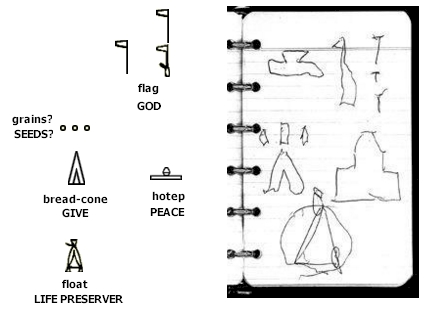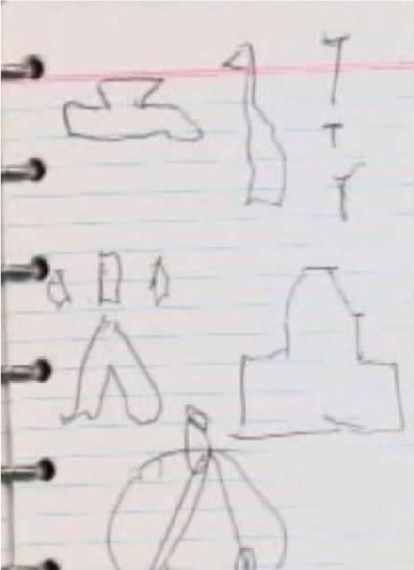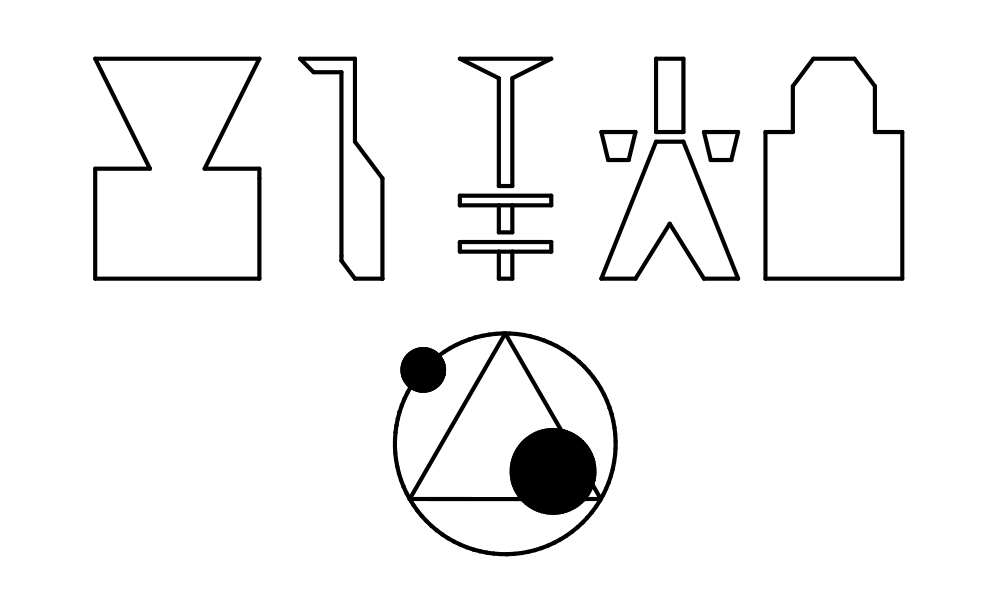It looks like you're using an Ad Blocker.
Please white-list or disable AboveTopSecret.com in your ad-blocking tool.
Thank you.
Some features of ATS will be disabled while you continue to use an ad-blocker.
10
share:
I recently visited a museum where Egyptian hieroglyphs were displayed. I saw two hieroglyphs there that looked a lot like two of the symbols scribbled
in Jim Penniston’s notebook.
In this picture, at the top right, you can see these same hieroglyphs. One looks like a fat capital A without the horizontal line, the other one is right next to it, a rectangular base with a cone on top:
picture
So I decided to dig in a little deeper.
Egyptian hieroglyphs each have a name, so I’ll give you the links to the lists with their names and refer to them by name from now on:
Names starting with A-L:
A to L
Names starting with M-Z:
M to Z
The two hieroglyphs I described above are ‘bread-cone’ and ‘hotep’. The bread-cone means ‘give’ and the hotep stands for ‘peace’. So together they mean something like ‘give peace’.
The bread-cone and the hotep can be recognized in Penniston’s scribbles, in the middle of the page. The bread-cone has three little things above it and the hotep seems a little too thick and narrow, but the basic shapes match:
Notebook scribbles
I even found a picture of a very ancient hotep hieroglyph that matches the general size and thickness of the one in Jim’s notebook:
ancient hotep
What about the rest of Jim’s scribbles? Could they be copies of hieroglyphs, too?
The first one, on the top left of the page, I could not identify. But the flag-like symbol next to it is the ‘flag’ hieroglyph, which stands for ‘god’. And the three vertical stripes next to it simply mean ‘plural’, i.e., ‘gods’ instead of ‘god’.
On the second line of the notebook page we have the bread-cone followed by the hotep, as explained, but what could these three things above the bread-cone mean?
It appears that three stripes next to each other can mean ‘plural’, but can also mean ‘we’ or ‘us’.
So together we have something like ‘gods we give peace’.
Now we can try the last one at the bottom of the page, the triangle within a sort of circle with things at two corners of the triangle. This could very well be the ‘float’ hieroglyph scribbled down in a hurry. The float stands for ‘to provide’, ‘to supply’, or ‘to equip’. It is a triangle, with a circular form around it and a smaller conical box at each corner of the triangle.
‘… gods we provide and give peace’ …?
It is interesting to note that, according to Wikipedia, ‘hieroglyphs’ meant ‘words of the gods’ in ancient Egypt.
Any thoughts? Any experts on hieroglyphs on this forum?
In this picture, at the top right, you can see these same hieroglyphs. One looks like a fat capital A without the horizontal line, the other one is right next to it, a rectangular base with a cone on top:
picture
So I decided to dig in a little deeper.
Egyptian hieroglyphs each have a name, so I’ll give you the links to the lists with their names and refer to them by name from now on:
Names starting with A-L:
A to L
Names starting with M-Z:
M to Z
The two hieroglyphs I described above are ‘bread-cone’ and ‘hotep’. The bread-cone means ‘give’ and the hotep stands for ‘peace’. So together they mean something like ‘give peace’.
The bread-cone and the hotep can be recognized in Penniston’s scribbles, in the middle of the page. The bread-cone has three little things above it and the hotep seems a little too thick and narrow, but the basic shapes match:
Notebook scribbles
I even found a picture of a very ancient hotep hieroglyph that matches the general size and thickness of the one in Jim’s notebook:
ancient hotep
What about the rest of Jim’s scribbles? Could they be copies of hieroglyphs, too?
The first one, on the top left of the page, I could not identify. But the flag-like symbol next to it is the ‘flag’ hieroglyph, which stands for ‘god’. And the three vertical stripes next to it simply mean ‘plural’, i.e., ‘gods’ instead of ‘god’.
On the second line of the notebook page we have the bread-cone followed by the hotep, as explained, but what could these three things above the bread-cone mean?
It appears that three stripes next to each other can mean ‘plural’, but can also mean ‘we’ or ‘us’.
So together we have something like ‘gods we give peace’.
Now we can try the last one at the bottom of the page, the triangle within a sort of circle with things at two corners of the triangle. This could very well be the ‘float’ hieroglyph scribbled down in a hurry. The float stands for ‘to provide’, ‘to supply’, or ‘to equip’. It is a triangle, with a circular form around it and a smaller conical box at each corner of the triangle.
‘… gods we provide and give peace’ …?
It is interesting to note that, according to Wikipedia, ‘hieroglyphs’ meant ‘words of the gods’ in ancient Egypt.
Any thoughts? Any experts on hieroglyphs on this forum?
a reply to: BlackSunDog
Thanks for the info, would you have a ref/link to Eric Oullet interpretation ?
Thanks for the info, would you have a ref/link to Eric Oullet interpretation ?
Given that Penniston's story has expanded like supernova since 1980 then I have major doubts.
In his original witness statement he never got close enough to see anything on the craft. So he's either been making up porkie pies or even worse someone has planted false memories in the guy.
I tend to think the idea from those symbols or glyphs that Penniston drew were inspired by someone looking at Egyptian hieroglyphics first.
In his original witness statement he never got close enough to see anything on the craft. So he's either been making up porkie pies or even worse someone has planted false memories in the guy.
I tend to think the idea from those symbols or glyphs that Penniston drew were inspired by someone looking at Egyptian hieroglyphics first.
a reply to: Guest101
Okay, well, thanks. What would have kept Penniston from seeing that as well? In other words: what has kept Penniston from referencing hieroglyphs when formulating his "symbols"?
In other words: So what?
I saw two hieroglyphs there that looked a lot like two of the symbols scribbled in Jim Penniston’s notebook.
Okay, well, thanks. What would have kept Penniston from seeing that as well? In other words: what has kept Penniston from referencing hieroglyphs when formulating his "symbols"?
...could be...
In other words: So what?
edit on 9-3-2016 by Bybyots because: . : .
What? No one likes that I said, "So what?"?
So what?
Listen, this is one aspect of this case that we all need to agree on:
This phenomenon? Based on how this case has gone?
It has two possible sources:
1. The goddamned weather.
2. Some technology that mimics the same phenomenon induced in people by the weather.
That phenomenon needs to have a purpose in the world.
You following me?
The weather needs no purpose, at least not one that requires any speculation to make this post work, so let's set that aside for right now.
Someone mimicking this weather phenom: Yes, it needs a purpose in the world, because purpose is what supports budgets.
You keeping up?
That purpose can be described as a "payload". The goddamned thing is out there because it is meant to deliver a payload.
That payload? Is these stupid "hieroglyphics" that this thread is referencing?
Any questions?
So what?
Listen, this is one aspect of this case that we all need to agree on:
This phenomenon? Based on how this case has gone?
It has two possible sources:
1. The goddamned weather.
2. Some technology that mimics the same phenomenon induced in people by the weather.
That phenomenon needs to have a purpose in the world.
You following me?
The weather needs no purpose, at least not one that requires any speculation to make this post work, so let's set that aside for right now.
Someone mimicking this weather phenom: Yes, it needs a purpose in the world, because purpose is what supports budgets.
You keeping up?
That purpose can be described as a "payload". The goddamned thing is out there because it is meant to deliver a payload.
That payload? Is these stupid "hieroglyphics" that this thread is referencing?
Any questions?
edit on 11-3-2016 by Bybyots because:
a reply to: Guest101
Just because a few random Egyptian hieroglyphs (from different periods) kind of have a similar geometric shape to some of the liar Penniston's doodles means nothing. The resemblances are a stretch, at best. If there were even just one that matched, you might be able to present a (rather poor) case, but you don't even have that.
Just because a few random Egyptian hieroglyphs (from different periods) kind of have a similar geometric shape to some of the liar Penniston's doodles means nothing. The resemblances are a stretch, at best. If there were even just one that matched, you might be able to present a (rather poor) case, but you don't even have that.
Interesting stuff, Guest101. Investigation such as this is not to be knocked. Keep at it.


edit on FriAmerica/ChicagofFri, 11 Mar 2016 10:00:25 -0600am1003America/Chicago331 by Defragmentor because: (no
reason given)
Thanks for that picture, Defragmentor, it really shows how the shapes of Jim’s glyphs match actual hieroglyphs.
Not only that, but together they seem to tell something about ‘gods who provide and give peace’.
(Many flags, of a flag followed by three vertical lines above each other, can be translated to ‘gods’, and the ‘float’ can also mean ‘to provide’ or ‘to equip’.)
I really don’t know what to think of it.
The binary codes are a proven fake to me (because they match the tele atlas Woodbridge coordinates of that time (2010) in 7 decimals, which is extraordinary since the public maps only had 6 decimal accuracy. Oddly, all other coordinates that followed after this criticism have 6 decimals).
So who made these glyphs, and why? Was it Jim? Did he just make up some random glyph-alike figures that happen to match? Did he copy them from a museum or website? Did he get help from someone?
As always: More questions than answers … and I don’t have the answers.
Not only that, but together they seem to tell something about ‘gods who provide and give peace’.
(Many flags, of a flag followed by three vertical lines above each other, can be translated to ‘gods’, and the ‘float’ can also mean ‘to provide’ or ‘to equip’.)
I really don’t know what to think of it.
The binary codes are a proven fake to me (because they match the tele atlas Woodbridge coordinates of that time (2010) in 7 decimals, which is extraordinary since the public maps only had 6 decimal accuracy. Oddly, all other coordinates that followed after this criticism have 6 decimals).
So who made these glyphs, and why? Was it Jim? Did he just make up some random glyph-alike figures that happen to match? Did he copy them from a museum or website? Did he get help from someone?
As always: More questions than answers … and I don’t have the answers.
new topics
-
Is the origin for the Eye of Horus the pineal gland?
General Conspiracies: 1 hours ago -
Man sets himself on fire outside Donald Trump trial
Mainstream News: 1 hours ago -
Biden says little kids flip him the bird all the time.
2024 Elections: 1 hours ago -
The Democrats Take Control the House - Look what happened while you were sleeping
US Political Madness: 2 hours ago -
Sheetz facing racial discrimination lawsuit for considering criminal history in hiring
Social Issues and Civil Unrest: 2 hours ago -
In an Historic First, In N Out Burger Permanently Closes a Location
Mainstream News: 4 hours ago -
MH370 Again....
Disaster Conspiracies: 4 hours ago -
Are you ready for the return of Jesus Christ? Have you been cleansed by His blood?
Religion, Faith, And Theology: 7 hours ago -
Chronological time line of open source information
History: 8 hours ago -
A man of the people
Medical Issues & Conspiracies: 9 hours ago
top topics
-
In an Historic First, In N Out Burger Permanently Closes a Location
Mainstream News: 4 hours ago, 14 flags -
The Democrats Take Control the House - Look what happened while you were sleeping
US Political Madness: 2 hours ago, 9 flags -
A man of the people
Medical Issues & Conspiracies: 9 hours ago, 8 flags -
Thousands Of Young Ukrainian Men Trying To Flee The Country To Avoid Conscription And The War
Other Current Events: 15 hours ago, 7 flags -
Man sets himself on fire outside Donald Trump trial
Mainstream News: 1 hours ago, 5 flags -
12 jurors selected in Trump criminal trial
US Political Madness: 17 hours ago, 4 flags -
Biden says little kids flip him the bird all the time.
2024 Elections: 1 hours ago, 4 flags -
4 plans of US elites to defeat Russia
New World Order: 11 hours ago, 4 flags -
Are you ready for the return of Jesus Christ? Have you been cleansed by His blood?
Religion, Faith, And Theology: 7 hours ago, 3 flags -
Sheetz facing racial discrimination lawsuit for considering criminal history in hiring
Social Issues and Civil Unrest: 2 hours ago, 3 flags
active topics
-
Biden says little kids flip him the bird all the time.
2024 Elections • 8 • : Astrocometus -
12 jurors selected in Trump criminal trial
US Political Madness • 82 • : Xtrozero -
Are you ready for the return of Jesus Christ? Have you been cleansed by His blood?
Religion, Faith, And Theology • 18 • : mysterioustranger -
Man sets himself on fire outside Donald Trump trial
Mainstream News • 16 • : SpaceghostL -
The Democrats Take Control the House - Look what happened while you were sleeping
US Political Madness • 19 • : DBCowboy -
Israeli Missile Strikes in Iran, Explosions in Syria + Iraq
World War Three • 101 • : CarlLaFong -
Thousands Of Young Ukrainian Men Trying To Flee The Country To Avoid Conscription And The War
Other Current Events • 26 • : Lazy88 -
George Knapp AMA on DI
Area 51 and other Facilities • 27 • : TheValeyard -
4 plans of US elites to defeat Russia
New World Order • 35 • : Oldcarpy2 -
Sheetz facing racial discrimination lawsuit for considering criminal history in hiring
Social Issues and Civil Unrest • 6 • : chiefsmom
10


